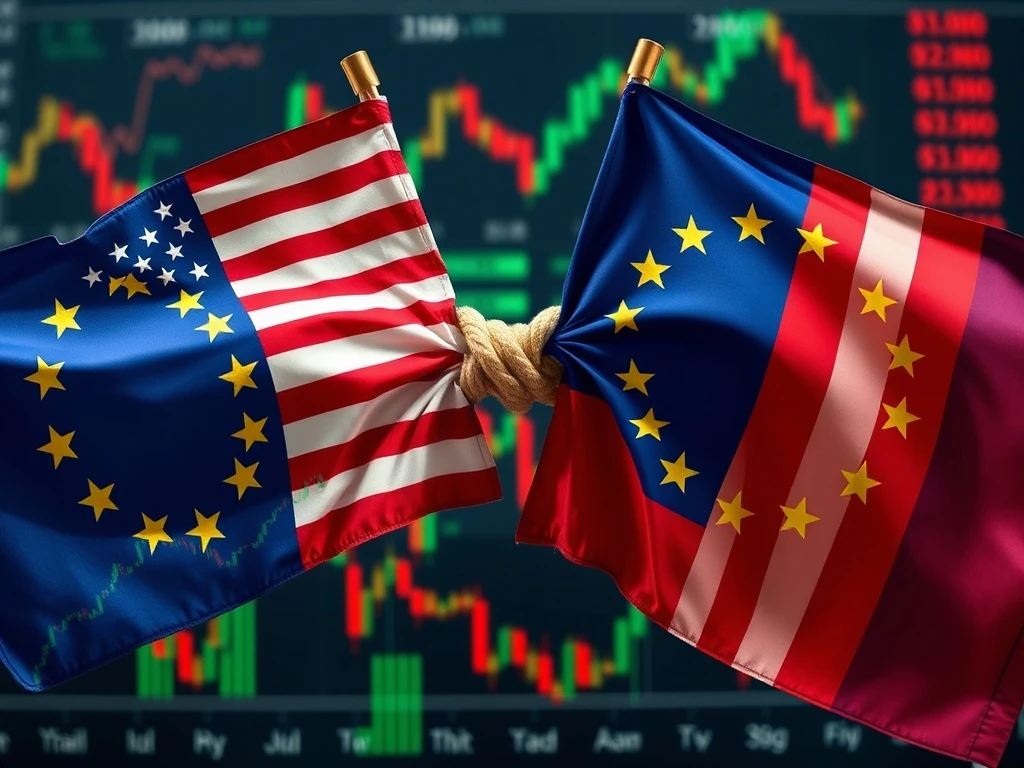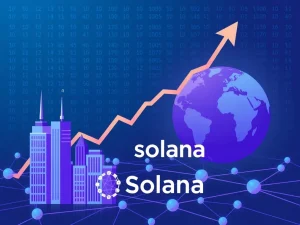US-EU Tariffs Unleash Turbulent Market Volatility Ahead of Critical August 1 Deadline

In the fast-paced world of finance, where every headline can trigger seismic shifts, the looming threat of escalated US-EU Tariffs has sent ripples across traditional markets, reminding us all of the interconnectedness of the global economy. Even for those deeply entrenched in the digital asset space, understanding these macro-economic pressures is crucial. The current market jitters, fueled by potential trade disputes, highlight how external policy decisions can influence investor sentiment, risk appetite, and ultimately, the broader financial landscape that often correlates with cryptocurrency movements. As the August 1 deadline approaches, traders and analysts are on high alert, navigating a complex web of unverified reports and official statements that threaten to ignite a full-blown Global Trade War.
The Escalating Saga of US-EU Tariffs: A High-Stakes Game
The air is thick with anticipation as the United States and the European Union find themselves at a critical juncture regarding trade relations. Unverified reports hinting at potential 30% US tariffs on EU imports have thrown global markets into a state of flux. This isn’t just about numbers; it’s about the potential for a significant disruption to established supply chains and international commerce. President Trump’s initial indications of reciprocal tariffs ranging between 15% and 50% – with higher rates aimed at nations deemed ‘difficult’ – set a challenging tone. However, subsequent discussions have offered a glimmer of hope, suggesting a last-minute agreement could reduce US tariffs on EU goods to a more palatable 15%, potentially averting the previously threatened 30% rate that had sparked concerns over severe retaliatory measures from the bloc.
The Financial Times and Bloomberg have noted that this 15% rate would likely apply to ‘most products,’ yet the ominous 30% threshold remains a contingency should negotiations falter. This uncertainty is a primary driver of the current Market Volatility, keeping investors on edge. The fluctuating figures underscore the unpredictable nature of trade negotiations and the constant need for market participants to adapt their strategies. The stakes are incredibly high, as the outcome will not only define the immediate future of transatlantic trade but also set a precedent for managing global economic disputes.
Navigating the Global Trade War Landscape: Who’s Next?
The potential escalation of US-EU Tariffs is not an isolated incident but rather a significant piece of a larger puzzle within the ongoing Global Trade War. This broader pattern of aggressive trade policy has seen the US imposing various tariff rates on multiple international partners. Understanding the context helps illuminate the current tensions:
- Japan: Previously faced 15% tariffs from the US.
- Indonesia: Confirmed agreements include 19% tariffs on their imports to the US, coupled with reciprocal investments into the US economy.
- Philippines: Similar to Indonesia, confirmed agreements feature 25% tariffs on their imports, also alongside investments into the US economy.
- India and Canada: These nations face considerable uncertainty, with President Trump having threatened tariffs ranging from 25% to 35%, though concrete details remain elusive.
Treasury Secretary Scott Bessent has hinted at more deals emerging in the coming days, but the lack of specifics regarding key trading partners like India and Canada only amplifies the prevailing uncertainty. This ‘deal-by-deal’ approach, while potentially yielding specific bilateral agreements, creates a climate of unpredictability for global businesses and supply chains. The EU’s readiness to retaliate, with Germany’s Chancellor Friedrich Merz cautioning about the severe impact of a 30% tariff on German exporters, underscores the potential for a cascading effect of protectionist measures worldwide. The reported finalization of an EU retaliatory package targeting over $100 billion in US goods further solidifies the notion that this is a two-way street, with significant economic repercussions for all involved.
Understanding Market Volatility: What’s Driving the Swings?
The current market environment is a textbook example of heightened Market Volatility, directly attributable to the shifting sands of trade policy. Equity indices globally are showing mixed reactions, reflecting the divergent expectations among investors: will there be a trade détente or an escalation of tensions?
A Bloomberg analyst observed that rumors of a 15% deal have temporarily bolstered risk appetite, leading to stocks gaining momentum as traders anticipate a resolution before August 1. This surge reflects the market’s innate desire for certainty and stability. However, the persistent threat of a 30% tariff, frequently highlighted in unconfirmed reports and President Trump’s weekend remarks, continues to exert significant pressure on specific sectors. The aviation industry, for instance, is particularly vulnerable. ePlaneAI has warned of potential market-share losses if higher tariffs are imposed, indicating how trade disputes can directly impact sector-specific profitability and competitive landscapes. This ‘swing’ between optimism and apprehension creates challenging conditions for investors, necessitating agile strategies and careful risk management. The speculative mood of the market underscores the dual risks at play: a partial resolution that offers temporary relief, or a full-blown escalation that could trigger a deeper economic downturn.
The Enduring Legacy of Trump Trade Policy: A New Paradigm?
The current tariff standoff with the EU is deeply rooted in the broader framework of Trump Trade Policy, characterized by a ‘America First’ approach and a willingness to use tariffs as a primary tool for negotiation. This policy paradigm aims to rebalance trade deficits and secure what the administration views as fairer trade terms for the United States. The Justice Integrity Project has noted that this tariff rhetoric has already strained transatlantic relations, with European leaders expressing frustration over the lack of predictability inherent in this approach. This unpredictability, a hallmark of the administration’s trade strategy, creates significant challenges for multinational corporations that rely on stable international trade agreements and predictable supply chains.
The consistent use of tariffs, from Japan to Indonesia, demonstrates a calculated strategy rather than isolated incidents. While proponents argue that this pressure forces trading partners to the negotiating table and secures better deals, critics point to the disruption it causes to global commerce and the potential for retaliatory measures that harm domestic industries and consumers. The approach signifies a departure from traditional multilateral trade agreements, favoring bilateral negotiations and the application of economic leverage to achieve specific national objectives. As the August 1 deadline looms, the world watches to see if this strategy will yield a favorable outcome for the US or lead to further trade fragmentation.
Assessing the Broader Economic Impact: Beyond the Headlines
The potential imposition of high US-EU Tariffs and the resulting Global Trade War escalation carry profound Economic Impact that extends far beyond immediate market reactions. For businesses, especially multinational corporations, the uncertainty necessitates extensive hedging strategies to mitigate risks associated with fluctuating costs and disrupted supply chains. Sectors heavily reliant on international trade, such as manufacturing, automotive, agriculture, and aviation, face direct threats to their profitability and market access. Higher tariffs translate to increased import costs for businesses, which can then be passed on to consumers in the form of higher prices, potentially fueling inflation and reducing purchasing power.
Conversely, export-oriented industries in countries facing tariffs could see a significant drop in demand for their products, leading to reduced production, job losses, and a slowdown in economic growth. The EU’s readiness to implement retaliatory tariffs on US goods means that American exporters, from agricultural products to industrial machinery, could also face reduced competitiveness in European markets. This cycle of tariffs and counter-tariffs can erode global economic confidence, deter foreign direct investment, and ultimately dampen global economic growth. The outcome of the US-EU tariff dispute will not only shape the immediate future of transatlantic trade but also set a significant precedent for how major economic powers manage disputes, with lasting implications for global supply chains, investor confidence, and the overall stability of the international economic order.
As the August 1 deadline draws near, stakeholders across the globe are left navigating a complex landscape defined by unverified reports, intense political maneuvering, and significant economic fallout. The resolution, or lack thereof, of the US-EU Tariffs issue will be a pivotal moment, shaping not only trade relations between two of the world’s largest economic blocs but also influencing the broader trajectory of the Global Trade War and its lasting Economic Impact on Market Volatility. For investors, businesses, and policymakers alike, vigilance and adaptability remain paramount in these turbulent times.
Frequently Asked Questions (FAQs)
Q1: What are the current US-EU tariff threats?
A1: Unverified reports suggest potential US tariffs on European Union imports could range from 15% to 30%. While President Trump initially indicated a broader range of 15% to 50% for reciprocal tariffs, more recent discussions point towards a possible agreement for a 15% rate on most products, though the 30% rate remains a contingency if negotiations fail before the August 1 deadline.
Q2: Why is August 1 a significant date for these tariffs?
A2: August 1 is highlighted as a critical deadline for a potential resolution or implementation of the threatened US tariffs on EU goods. Market participants are closely monitoring this date, as a deal before then could ease market fears, while a lack of agreement could trigger the higher 30% tariffs and potential retaliatory measures from the EU.
Q3: How might these tariffs impact global markets and specific sectors?
A3: The uncertainty surrounding the tariffs has already fueled significant market volatility, with equity indices showing mixed reactions. If higher tariffs are imposed, sectors like aviation could face market-share losses, and overall global supply chains could be disrupted. Higher import costs could lead to increased consumer prices and reduced purchasing power, while retaliatory tariffs from the EU could harm US exporters.
Q4: What is the EU’s stance on retaliatory measures?
A4: European officials have signaled their readiness to retaliate if higher US tariffs are imposed. Germany’s Chancellor Friedrich Merz has warned of severe impacts on German exporters, and the EU is reportedly finalizing a retaliatory package targeting over $100 billion in US goods, though specific details remain undisclosed.
Q5: How does this US-EU tariff issue fit into broader US trade policy?
A5: The US-EU tariff issue is part of a broader pattern of Trump’s trade policy, which has seen the imposition of tariffs on various countries like Japan (15%), Indonesia (19%), and the Philippines (25%). This policy is characterized by a focus on bilateral agreements and the use of tariffs as a tool to achieve specific trade objectives, often leading to unpredictability in global trade relations.









